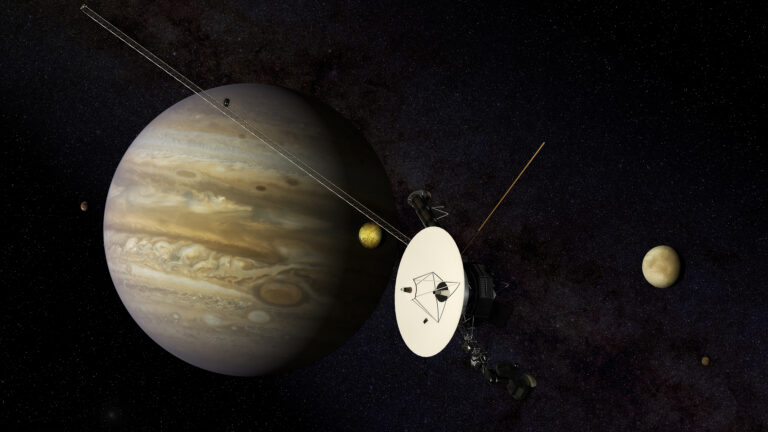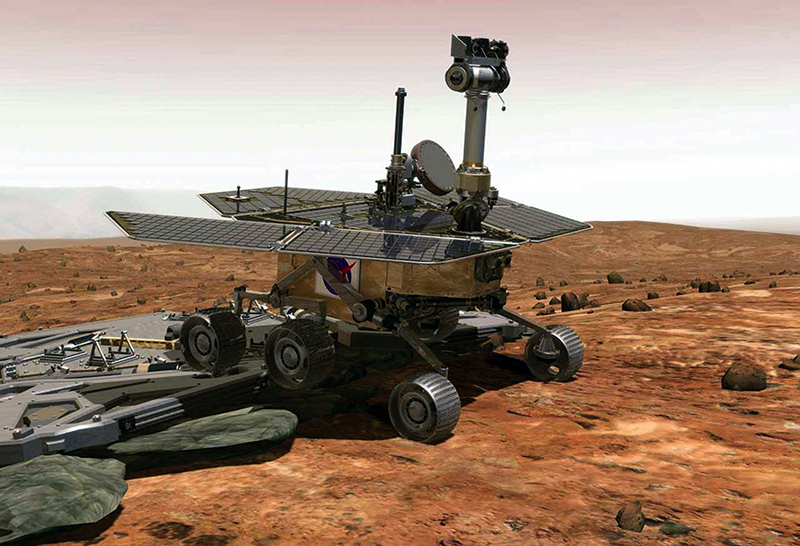Key Takeaways:
We may never know exactly what happened to the ESA’s Beagle 2 lander back in 2003, but we may be one step closer.
For over a decade, the ESA’s Beagle 2 lander was lost without a trace. It separated from the Mars Express Orbiter in late December 2003, headed for a Christmas Day landing on the red planet, but it never checked in from the surface, and for a decade no one knew what had become of Beagle 2. NASA’s Mars Reconnaissance Orbiter spotted it in 2014 and sent home eight very pixelated images from MRO’s HiRISE camera, but the satellite photos shed little light on the lander’s fate.
HiRISE has a resolution of about one or two feet per pixel, which is great for imaging landscape features but not quite sharp enough to capture details of a small derelict lander. “You are working at the limits of the resolution of the HiRISE camera,” explained former Beagle 2 mission manager Mark Sims, now director of the Space Research Center at the University of Leicester in the UK. “Beagle 2 is less than eight pixels across with the HiRISE camera. Even with advanced processing, you cannot fully resolve the different parts.”
At the time, it looked like Beagle 2 had deployed two or three of its four solar panels, but that was all anyone could really tell. That pointed to a crash landing whose cause looked likely to remain unknown.
It’s impossible to see much detail in the HiRISE images, but Sims figured that if he could work out what those images would look like if Beagle 2 had landed one way or another, then he could determine which version best matched the real image, and thereby learn what happened to his lander. He calls the technique reflection analysis, because it compares how sunlight reflects from bright surfaces on the lander in models and reality.
To pull it off, a team led by Nick Higgett, leader of the Digital Research Group at De Montfort University in the UK, built a highly accurate 3D model of Beagle 2. It was especially important that its solar panels and reflective insulation reflect the sunlight realistically, and the team simulated the light filtering through the Martian atmosphere at the same angle as in the HiRISE images. Once the team had those images, they had to pixelate them so they’d match HiRISE’s resolution.
Higgett and his team simulated Beagle 2 resting on the Martian surface at different angles, with different numbers of solar panels unfolded in different ways, and looked for the version that best matched the way light reflected off the lander in the real HiRISE photos. They plan to publish their results soon, but until then, says Sims, the details of the technique remain proprietary.
No Crash After All
Two of their simulated configurations reflected sunlight in a way that closely matched the real-world HiRISE images. In one version, three of the four solar panels had deployed. In the other, all four panels had deployed.
“With the analysis so far, we can’t tell which configuration reflects reality,” said Sims, but either one means everything came agonizingly close to going right for Beagle 2. If at least three panels deployed, that means that Beagle 2 made a safe, controlled landing, which means its entry, descent, and landing systems worked as planned.
That idea also gets some support from simulations of Beagle 2’s heat shield. The simulation that best matched the HiRISE images put the heat shield on the Martian surface just about where it should have landed after being released from Beagle 2 as scheduled.
Those findings, according to Higgett, “indicate that Beagle possibly came very, very close to actually working.”
“It enables the team to see how well the succeeded and enables closure on what looked like an unknown failure and total loss back in 2003 – and now looks like being excruciatingly close to a success,” said Sims. That conclusion may give the Mars Express team some closure, but it still doesn’t explain why Beagle 2 was never heard from after landing; if anything, it deepens the mystery.
Shedding More Light on Beagle 2
Unsurprisingly, there are a lot of things that can go wrong when a spacecraft tries to land on Mars. “Engineering analysis shows that there are over 180 functions or events that could have led to loss of the mission,” said former Beagle 2 chief engineer Jim Clemmet, now retired.
Although the current results don’t completely answer the question of Beagle 2’s fate, they narrow it down considerably. Knowing that Beagle 2 landed successfully but simply failed to report back to Mars Express – which is the biggest result of the simulations –rules out most of those 180 potential problems, and if it turns out that all four solar panels actually deployed properly, that narrows the list down to just 25 events that could have damaged Beagle 2’s electronics or wiring harness, according to Clemmet.
That means Sims and his team need to answer the big question of whether just three, or all four, solar panels fully deployed. If the fourth solar panel never opened, it would have blocked transmissions from the lander’s RF antenna, which would have been underneath the folded solar panel. On the other hand, if that fourth solar panel did open, then something else must have gone wrong with the lander to keep it from communicating. That could have been a software error or something as simple as a depleted battery.
The team hopes to turn to reflection analysis to tackle that question. To do that, they hope to get additional images of the landing site, which will hopefully show Beagle 2 in sunlight from different angles. Then they’ll build even more simulations of the solar panels in different configurations, where the fourth solar panel either unfolded, didn’t unfold, or stopped somewhere short of its full 160° deployment angle. With any luck, they’ll find a match between the real images and one of those simulation scenarios.
That is likely to be a £6,000 to £10,000 project, according to Higgett.
Of course, reflection analysis can only shed light on what position Beagle 2’s solar panels ended up in. It can’t address those other causes, like electrical failures or software problems, and it probably can’t explain why the fourth panel may not have deployed. “There is also further work (engineering analysis) to be done on trying to investigate the possible causes with the hope of coming down to just one,” Clemmet said.
Lessons Learned
Ultimately, the work may benefit future missions to Mars. Landing on Mars is, it turns out, not actually an easy task, as the recent loss of ESA’s Schiaparelli lander to a software problem demonstrated. They call it rocket science for a reason, after all, and understanding what went wrong with Beagle 2 may help future missions succeed more fully.
“Understanding failure modes is critical to better designs of spacecraft,” said Sims. “Understanding the design changes needed from the lessons learned is a key way future missions can avoid problems.”
To some extent, that’s already happening. Schiaparelli sent home a wealth of useful telemetry on its way down, which is how the ESA knows what went wrong in so much detail, but its loss, too, would have been a mystery if the lander hadn’t been in radio contact with the ExoMars orbiter during its final descent. The ESA began requiring landers to keep in touch with their orbiters during descent in the wake of Beagle 2’s demise.
“I feel deeply disappointed for the ExoMars Schiaparelli lander team, having gone through the experience of Beagle 2,” said Sims.










